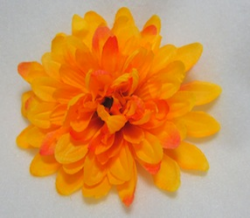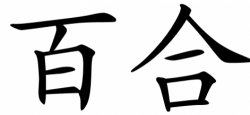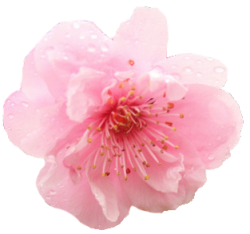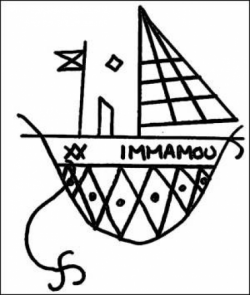What's the meaning of the Chrysanthemum »
Chrysanthemum
This page is about the meaning, origin and characteristic of the symbol, emblem, seal, sign, logo or flag: Chrysanthemum.

In parts of eastern Asia, the chrysanthemum is extremely important as a cultural symbol. Although the lotus flower has symbolic meaning across a larger swath of the continent, in China and Japan it runs into some stiff competition from this golden-hued beauty.
The word chrysanthemum is a combination of two Greek words: “chrysos” meaning ‘golden’ and “anthemum” meaning ‘flower’. Although chrysanthemums can occur in a range of different colors, the golden variety is the most famous, and this coloring accounts for part of its symbolic importance.
The chrysanthemum has served as the official emblem of the Japanese Imperial family for centuries, and the Emperor was said to occupy the “chrysanthemum throne”. Due to its golden color, the chrysanthemum also functions as a solar symbol, and since the Imperial family traditionally claimed descent from the sun goddess Amaterasu-ōmikami, the importance of the flower speaks for itself.
Due to its many layers of petals, chrysanthemums are symbols of longevity and immortality. They also represent joy and happiness; in Japan today, there is a festival called Kiki no Sekku which, drawing on chrysanthemum symbolism, is dedicated to those values.
In China, the chrysanthemum is one of the “Four Gentlemen” of Confucian tradition, which also includes the plum, orchid and bamboo. Each of these plants represents a season, and since chrysanthemums typically bloom into the autumn, they are associated with that season. The Chinese also traditionally held harvest festivals during the ninth lunar month on the calendar. These festivals were associated with chrysanthemums and may have influenced the Japanese Kiki no Sekku.
- 2,189 Views
Graphical characteristics:
Asymmetric, Closed shape, Colorful, Contains curved lines, Has no crossing lines.
Categories: Chinese Symbols, Plants, Trees, and Flowers, Religious Symbols.
Chrysanthemum is part of the Shinto group.
More symbols in Shinto:
Shinto (神道 Shintō?) or Shintoism, also kami-no-michi, is the indigenous spirituality of Japan and the people of Japan. It is a set of practices, to be carried out diligently, to establish a connectio… read more »
More symbols in Chinese Symbols:
China is one of the world's oldest and most long-lived cultures, with human settlement dating back to the Neolithic Era. Covering a vast region of eastern Asia, its many customs and traditions can va… read more »
More symbols in Plants, Trees, and Flowers:
The natural world is home to a vast variety of symbols, and plants, trees and flowers are among the most symbolically charged objects you'll ever encounter. Some of their symbolic meanings are w… read more »

More symbols in Religious Symbols:
Religious symbolism is the use of symbols, including archetypes, acts, artwork, events, or natural phenomena, by a religion. Religions view religious texts, rituals, and works of art as symbols of co… read more »
Citation
Use the citation below to add this symbol to your bibliography:
Style:MLAChicagoAPA
"Chrysanthemum." Symbols.com. STANDS4 LLC, 2024. Web. 27 Jul 2024. <https://www.symbols.com/symbol/chrysanthemum>.






















Have a discussion about Chrysanthemum with the community:
Report Comment
We're doing our best to make sure our content is useful, accurate and safe.
If by any chance you spot an inappropriate comment while navigating through our website please use this form to let us know, and we'll take care of it shortly.
Attachment
You need to be logged in to favorite.
Log In